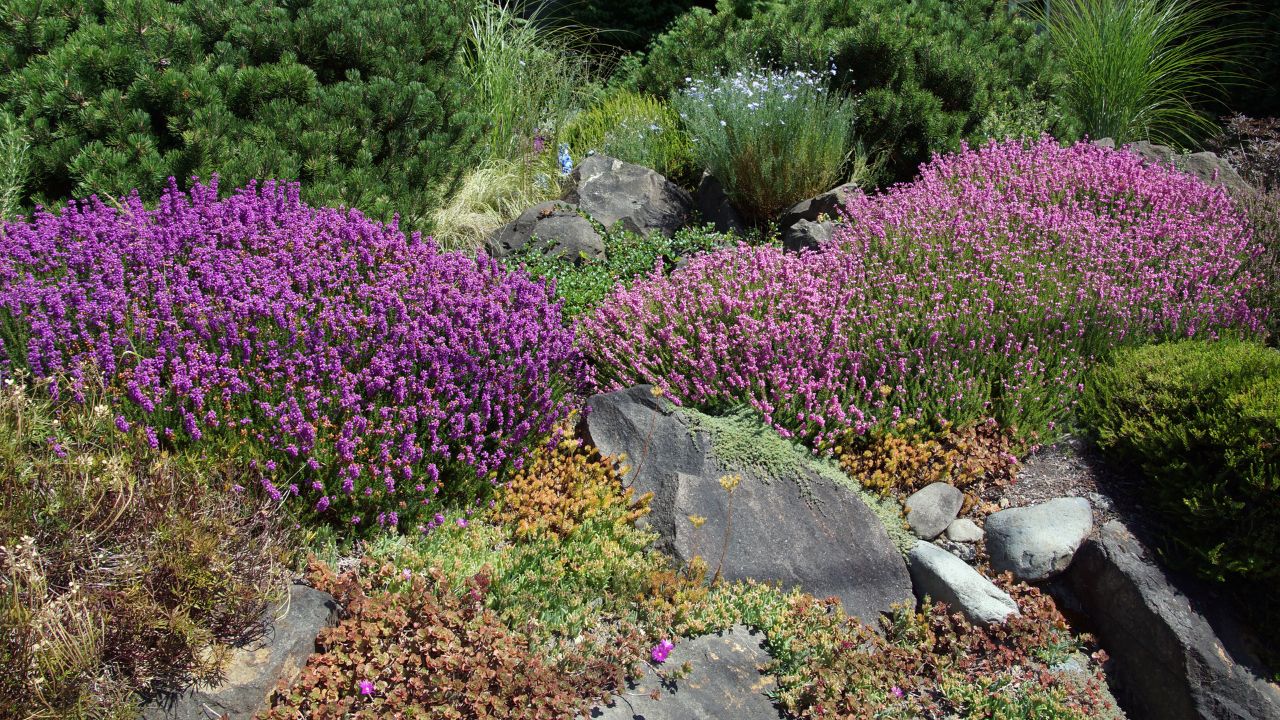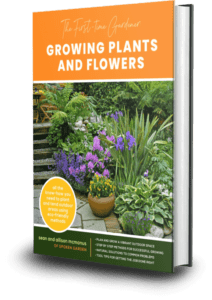Learn about drought-tolerance and some really fun drought-tolerant flowering plants for your garden.
These magical perennials have it all. They are drought-resistant, cold-resistant, deer-resistant, and they attract tons of pollinators. Can you ask for a better summer or fall-blooming plant?
Also known as Echinacea, their purple, pink, orange, or red hues will jazz up your garden with their cone-shaped flowers. In this coneflower plant profile, you’ll learn about the unique characteristics of this plant as well as basic plant care and companion plants for your landscape.
If you’re already lucky enough to have these perennials in your garden but you are unsure how to best care for them, this post will teach you the skills you’ll need. Or, if you are new to gardening and want to add these to your landscape but you’re scared you might kill them with your black thumb, don’t worry. This post will give you the confidence you need to grow and care for them with our coneflower plant profile table and free printable guide.
No matter what you’re gardening level is, by the end of this post you’ll learn:
- Drought-tolerance overview
- Annual and perennial drought-tolerant flowering plants
- Herbaceous and hardwood perennial drought-tolerant plants
- And more…
Let’s get started on helping you better understand drought-tolerant landscaping and plants!
Before we begin, if you’re looking for one way to start creating a more drought-tolerant landscape, there are several tools, supplies, and strategies that will work together to lower the overall water use in your yard. This could be added to your current landscape to help save precious resources.
For example, this specific water conservation tool by Orbit would be a great start for your drought-tolerant garden! It’ll help you monitor the time your water is running and therefore lessen the amount of water that is used. Plus, you can set the timer for when it goes off!
Our water timer has been a huge benefit in our yard and we couldn’t imagine life without it (yes, we’re a tad bit dramatic but we really love it)! Pick up your own today!
Introduction to Drought-Tolerance
Congratulations to you on your decision to create a more water-wise landscape!Drought-tolerant landscaping
As our climate continues to change and get warmer, it’ll be more important than ever to maintain a garden with plants that are designed to use fewer resources overall. Of course, all perennials need to be well-established for a year or two before they can be considered drought-tolerant. Luckily, there are so many ways to alter your landscape in order to use less water as well as less of other resources.
First, you need to begin your journey with a basic definition of drought-tolerance. Drought-tolerance relates to certain plants, including shrubs, trees, or herbs, that have the ability to survive (and even thrive) under very low levels of available water, for up to a week or two. On the other hand, drought-resistant plants have the ability to sustain low water levels for months at a time and is often confused with drought-tolerance. Either type of landscape is beneficial to the environment, it just depends on your preference.
Next, you need to choose your plants based on your needs. There are several beautiful drought-tolerant perennials, shrubs, grasses, groundcovers, and trees that can sustain low levels of water for many weeks at a time.
Examples of drought-tolerant plants:
- Purple Coneflower
- Blanket Flower
- Rhododendron
- Vinca
- Salal
Check out our more extensive list of drought-tolerant perennials and drought-tolerant supplies below to help you along your journey to create a low-water landscape.
So, you might ask “what is drought tolerance”?
This refers to a plant being able to survive and even thrive under very low levels of available water in its surrounding environment for a specific amount of time. This also can be applied to plants that can survive in very arid and event desert-like conditions that might not otherwise be subjected to this extreme in their normal climate or native areas.
Now, how can some plants be more drought tolerant than others?
All plants have adapted to their native environments where some plants have additionally naturally adapted to drier conditions than those native climates. This adaptation allows these plants to grow and live in a wider range of water conditions, more on the extreme ends of a water range spectrum.
Why is this important and why you should care ?
Misconceptions of drought-tolerant plants:
- These plants are ugly; this is completely untrue! Plants that are drought-tolerant, but are AMAZINGLY beautiful are the Purple Coneflower, Blanket Flower, Rhododendron, Salal, Vinca, Pine/Fir/Spruce/and Juniper trees and shrubs and many more.
- Drought-tolerant plants don’t need any water at all; not true. Most plants need at least miniscule amounts of water to sustain themselves and drought tolerant plants still need little to low amounts of water every once in a while.
- These plants only grow in certain places of the region or country; not at all. All over the world there are drought tolerant plants that can take many shapes and forms to completely thrive in almost any climate and location that you had no idea they could do that. A really good example of an extreme plant that can thrive in drought conditions is Rusty Sedge or Carex subfusca. Loves moist shady climates, but can tolerate drought just fine. Another is the Ponderosa Pine or Pinus ponderosa which can tolerate a range of conditions including drought conditions. This is a highly adaptive pine tree that stretches from British Columbia down to Mexico and from the Pacific coastal ranges east to Nebraska. See, very adaptable and cool.
Benefits of a drought-tolerant garden
On one of our previous podcasts, we discussed the benefits of drought-tolerant plants to help you begin your journey of creating a water-wise garden.
- Lower water needs during droughts = lower water bill
- Also lower inputs and maintenance, as most of these plants are easy to maintain
- More wildlife habitat
- And, less plant disease and more pest resistance.
4-step design system:
1) Determine your climactic zone by finding out what USDA or Sunset climatic zone your garden is in.
2) Research each drought-tolerant plant you are interested in according to what would grow well in your garden’s specific climatic zone. There are many plants suitable for each zone, so don’t even worry that there might not be enough plants to choose from.
3) Once you have figured out your drought-tolerant plant list, sort the plants into groups according to which plants will grow and thrive in the same conditions. For example, which plants from your list need full-sun, shade, partial shade, or fast or slow-draining soil? Also, what watering frequency does each plant prefer?
4) Now, organize your plant groupings by the plants’ height at full maturity as well as width. This will help you determine what should be planted where.
Different Levels of Drought-Tolerance
The problem is you are unsure how to begin, what to plant, or how to design this new low-water landscape because you’re not a landscape designer and you want to get it right.
There are three distinct levels of drought-tolerance in gardens that we want to help you understand. Of course, these could be broken down into further sub-groups, but we are going to cover our three basic levels today.
Before we get into the actual levels of drought-tolerance you can have in your garden, we need to lay some ground-rules and set up the garden scene. In all three of these levels, the garden will be in the same climatic zone with same temperatures and cold hardiness, same sun exposure, have the same amount of rainfall, same location in the garden or yard, same soil, and have the same things around it. So, let’s set this up!
Our scenario garden is located in USDA hardiness zone 8b with hardiness temperatures down to 15-20 degrees fahrenheit. This zone is found in other US locations like inner coastal areas of Oregon and California, or Arizona, New Mexico, North and South Carolina, and other southern US States. Interesting mix, wouldn’t you say?
Our garden will have a full sun SW Exposure, get about 40-inches of rain a year, be located between a hillside and a walking path, have a soil mix of clay and organic matter, and have some larger Fir and Maple trees up on the hill behind this garden area, and has the ability to be a traditional garden with lots of watering and fertilizing all the way to a garden with as little inputs as possible, and still thrive.
Drought-Tolerant Landscape Plants
Most home landscape areas have moderate the regular watering needs, has a moderate to larger grass area, has a higher maintenance level need where three or more times a year most plants will need some kind of repeated care or handling, and have a mix of perennial and annual flowering plants needing regular fertilizing and dead-heading (every week or two).
Listed below are some fun drought-tolerant annuals and some perennials you can add to your garden to help make your gardening a little easier:
- Geraniums
- Petunias
- Begonias
- Zinnias
- Vinca
- Hydrangeas
- Dahlias
- Butterfly Milkweed
- Shasta Daisy
- Campanula
- Roses
- Clematis
- ADD MORE??
Drought-Tolerant Herbaceous or Hardwood Perennials
Drought-tolerant plants are not unattractive or colorless. There are so many sizes, shapes, and colors available it really is just a matter of your preference.
Adding any one of these plants below to your landscape could beautify your yard while helping save precious water.
Here are a few of our favorites with links to buy them now:
- English Lavender – Purple herb/flower seeds
- Common Yarrow– Red flower seeds
- Rosemary – Herbal shrub seeds
- Russian Sage – Blue shrub seeds
- Purpletop Vervain – Purple seeds
- Coreopsis – Yellow flower seeds
- Yew Tree – Live plant
- Mint – Pinkish-purple herb seeds
- English Laurel
- Juniper shrubs
- Salal
- Vinca – Purple groundcover
- Rhododendron – Purple live plant
- Various ornamental grasses – Live pink Muhly grass
- Fir, Pine, Spruce, and Arborvitae trees
Drought-Tolerant Landscape Supplies
Now that you have picked out your plants and learned how to properly design your landscape, you need the proper tools for caring for them. This is a crucial step along your journey to great plant care, almost as important as choosing the plants themselves. The question is do you have all the tools you need?
If not, below are some recommendations to specific tools we use that will support your new drought-tolerant landscape.
For example, this water timer is a great tool for your drought-tolerant landscape. By setting the timer to the length or frequency you want, you’ll save time and money. We love our Orbit water timer and we feel good knowing that we only use water as needed.
Other Recommended Supplies:
Education for Drought-Tolerance
Further your education with these great book suggestions!
Waterwise Plants for Sustainable Gardens: 200 Drought-Tolerant Choices For All Climates
Lawn Gone!: Low-Maintenance, Sustainable, Attractive Alternatives For Your Yard
Video for Drought-Tolerant Perennials
Further your education along your journey to save more water with these two videos! We hope they are helpful!
Summary:
- Drought-tolerance refers to plants that can sustain low levels of water for a couple of weeks at a time.
- Research various types of drought-tolerant perennials you might like.
- Design your landscape using our 4-step drought-tolerant design system: Determine your zone, research your plants, sort/group your plants, and then organize by mature growing needs.
Drought-Tolerant Landscape Conclusion
Drought-tolerant perennials do not have to be boring, ugly, or colorless. You can add color, texture, and interest to your landscape by choosing tough plants that are environmentally-friendly and low maintenance.
By implementing our 4-step design system and using various tools like this water timer, you can save both water and money so that’s also a huge bonus!
Now it is time to hear from you!
What new questions do you have about drought-tolerant perennials or landscape design? Let us know by leaving a quick comment below. Leave a quick comment below and let us know!
See you in the garden!
~ Sean and Allison
P.S. Find us on Pinterest, Twitter, Facebook, and Instagram so you don’t miss a thing!
P.P.S. Before you go, don’t forget to collect your free coneflower plant reference guide!
Drought References:
- “Drought-Tolerant Plants For Dry Soil” – HGTV
- “Best Drought-Tolerant Perennials” – Better Homes & Gardens
- “Xeriscaping” – National Geographic
- “Xeric-, Water-Wise, Drought-Tolerant: What Does It All Mean?” – Sunset Magazine
Spokengarden.com is a participant in the Amazon Services LLC Associates Program, an affiliate advertising program designed to provide a means for sites to earn advertising fees by advertising and linking to Amazon.com
Learn about drought-tolerant landscaping levels for your garden, including watering frequencies, types of plants, and more.








